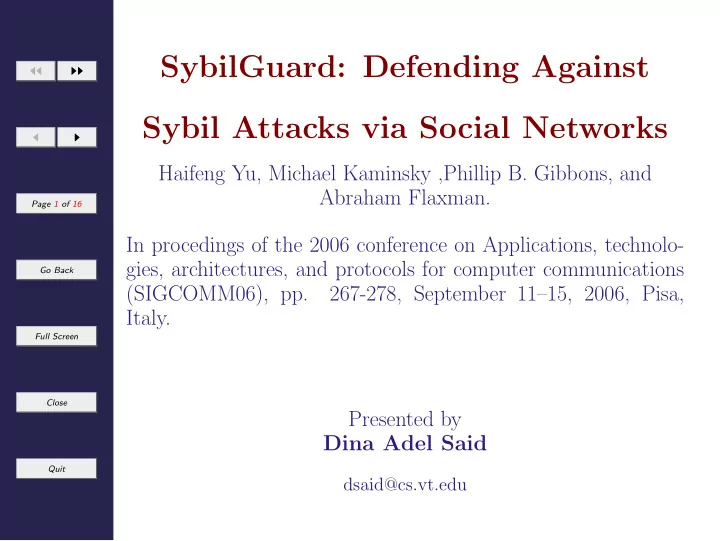

SybilGuard: Defending Against ◭◭ ◮◮ Sybil Attacks via Social Networks ◭ ◮ Haifeng Yu, Michael Kaminsky ,Phillip B. Gibbons, and Abraham Flaxman. Page 1 of 16 In procedings of the 2006 conference on Applications, technolo- gies, architectures, and protocols for computer communications Go Back (SIGCOMM06), pp. 267-278, September 11–15, 2006, Pisa, Italy. Full Screen Close Presented by Dina Adel Said Quit dsaid@cs.vt.edu
Problem Definition ◭◭ ◮◮ • Sybil attacks: multiple fake identities ◭ ◮ that pretend to be multiple, distance nodes in the system. Page 2 of 16 • Problem: may out vote the honest users in the collaborative tasks. Go Back Full Screen Close Quit
Solutions ◭◭ ◮◮ • Central authority ◭ ◮ – Difficult to find a single entity that is trusted worldwide Page 3 of 16 – Single point of failure – single target of denial-of-service attacks – Bottleneck of performance Go Back – The requirement of sensitive information or payment Full Screen • Binding an identify to an IP-address – IP harvesting Close – co-opt a large number of end-user machines Quit
Solutions (cont.) ◭◭ ◮◮ • Resource challenges approaches ◭ ◮ – Posted/validated simultaneously – Adversary can have more resources than the Page 4 of 16 typical user • Network coordinates Go Back – Can be fabricated • Historical behavior Full Screen – Not sufficient Close Quit
SybllGuard ◭◭ ◮◮ • Limits the corruptive influence of Sybil ◭ ◮ attacks • Build trust peer-to-peer relation between Page 5 of 16 honest nodes. Go Back • Limit the number of attack edges be- tween honest and malicious nodes. Full Screen Close Quit
Social Network ◭◭ ◮◮ • How? ◭ ◮ – Undirected edge between two nodes if they have strong relationship Page 6 of 16 – Routes are uniformly randomly generated – Convergence Property – Back-traceable property Go Back – A common edge must exist in the route be- tween verifier and suspect nodes Full Screen • Bounding Number of Attack Edges – Malicious users can establish social trust with Close honest users. – If Malory convinced Alice to trust more mali- cious nodes, the number of attack edges will be Quit the same.
Bounding the number of Sybil ◭◭ ◮◮ Groups to g and Group size to w ◭ ◮ • Why? – Maintaining replicas of a file − > use ( gw + 1) Page 7 of 16 replicas – Authentication − > use (2 gw + 1) nodes Go Back Full Screen Close Quit
Bounding the number of Sybil ◭◭ ◮◮ Groups to g and Group size to w ◭ ◮ • How? – Limit Number of attack edges to g Page 8 of 16 – Limit the No. of distinct random routes to w – Accept only one node at a given interestion point and adjacent edge Go Back Full Screen Close Quit
Problematic Random Routes ◭◭ ◮◮ • Causes: ◭ ◮ – Loops – Enters a Sybil region Page 9 of 16 • Loop can only form at the starting node p = 1 /d 2 ) • Redundancy Go Back • Use a threshold t for number of interesting routes • Tradeoff of t : ( d = t/ 2 ) Full Screen Close Quit
Registration of Random Path ◭◭ ◮◮ • Tokens ◭ ◮ – Public/Private Key authentication – Does not prevent Sybil nodes Page 10 of 16 • Shared key (symmetric ) authentication for edge keys. Go Back Full Screen Close Quit
Results ◭◭ ◮◮ • Using a million-node Graph and varying ◭ ◮ the number of attack edges • Probability of routes remaining entirely Page 11 of 16 within the honest region is nearly 100% for majority routes Go Back Full Screen Close Quit
Results (cont.) ◭◭ ◮◮ • Probability of an honest node accepting ◭ ◮ another honest node (TN) is nearly 100% for redundancy > = 10 Page 12 of 16 Go Back Full Screen Close Quit
Advantages ◭◭ ◮◮ • Decentralized Protocol ◭ ◮ • Succeed in limiting the number of mali- cious groups and their size Page 13 of 16 Go Back Full Screen Close Quit
Problems ◭◭ ◮◮ • It does not limit the Sybil nodes. Increasing the ◭ ◮ number of Sybil nodes may not significantly affect the performance while limiting their influence but it will increase computational complexity. Page 14 of 16 • The authors did not provide an experimental eval- uation study in terms of computational complex- Go Back ity. • The authors did not examine the probability of accepting malicious node (FN) Full Screen • The authors limits the number of attack edges to g by limiting the degree of the node with some Close constant (30). Quit
◭◭ ◮◮ ◭ ◮ Page 15 of 16 Go Back Full Screen Close Quit
◭◭ ◮◮ ◭ ◮ Page 16 of 16 Thank you Go Back dsaid@cs.vt.edu Full Screen Close Quit
Recommend
More recommend